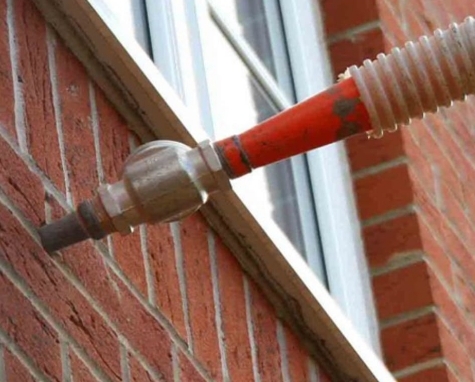
In situ post-insulation of cavity walls

Within the in situ post-insulation of cavity walls, insulation is inserted in the cavity through holes made in the outer leaf or inner leaf. This technique diminishes heat losses through the cavity walls of the house. It is a suitable technique for energetically renovating an existing house.
To diminish the risks, installers need to apply the technique in conformity with the conditions of STS 71-1, established by FPS Economy. BCCA has developed a quality framework on the basis of these STS.
Nevertheless, installers and house owners need to be aware that certain side effects can appear when using this post-insulation technique.
Always be careful when assessing the suitability of the cavity wall for post-insulation
While many homes are suitable for post-insulation technology and the above-mentioned side effects demonstrate that the insulation material is fulfilling its purpose, this is not the case for all houses.
If you are facing a moisture damage case, you can report it here.
As a certification body, BCCA cannot handle your individual claim, but knowledge about your claim can help prevent other claims.
What are the side effects of post-insulating cavity walls?
The possibility of ventilation through the cavity has vanished
- In principle, this poses no problem for non-painted brick masonry. The cavity wall will then dry out through the outer leaf. The higher exposure to rain, the longer it will take.
- A vapourtight finishing of the façade augments the risk of humidity transport towards the interior, because the wall can’t dry out as well.
Surface condensation and mould formation
- In principle there is no risk of surface condensation and mould formation for existing buildings that didn’t show any humidity problems prior to post-insulation. A post-insulated cavity wall experiences a higher mean temperature than a non-insulated cavity wall.
- Thermal bridges account for higher thermal losses. By additionally providing insulation solutions at these thermal bridges, the thermal losses can be limited.
- The insertion of insulation in the cavity renders the house more airtight and there’s a chance that a comfortable indoor climate can no longer be achieved. Insufficient heating and ventilation can cause surface condensation and mould. We therefore recommend installing a natural or mechanical ventilation system.
The outer leaf dries out slower
-
In the winter, the outer leaf heats up less from the inside. Therefore, the drying process of the outer leaf is slowed down. This phenomenon manifests itself especially where there’s a higher exposure of the outer leaf to rain and humidity, as is the case for example at the foot of the wall (due to road spray). This is a normal consequence of the post-insulation and indicates the insulation material is properly working.
If the application conditions of the STS 71-1 are respected during the insulation works, this phenomenon will yield no additional risks with regards to accelerated degradation of the façade.
Differences in colour and appearance
- Backfilling the holes with joint mortar can cause slight differences in colour and appearance. The holes will then sometimes be more distinct due to differential ageing.
Quality framework BCCA
CCA has developed a quality framework for the post-insulation of cavity walls with a nominal cavity width of at least 50mm. The framework fits in the STS 71-1, published by FPS Economy. Installers can obtain an ATG-certificate from BCCA with which they can show they are capable of working in conformity with the conditions of the STS 71-1 and actually do so.
What does the quality framework mean in practice?
- 01Prior to the beginning of the insulation works, an in-depth preliminary inspection needs to be performed in order to judge whether or not the cavity wall is suitable for post-insulation.
- 02Only trained and qualified personnel may proceed with this verification.
- 03Personnel needs to use appropriate equipment and should work in conformity with the prescriptions.
- 04The installers should work with appropriate raw materials and systems that are part of a Technical Approval ATG for this specific application. The Technical Approvals are to be found on the website of the Belgian Union for Technical Approval in Construction (www.butgb-ubatc.be).
How do you know whether an installer is certified?
De website of BCCA lists all certified installers. Each certificate is unequivocally linked to the usage of a certain product or system.
Are there subsidies for post-insulation?
In the Flemish Region, the Vlaams Energie- en Klimaatagentschap VEKA grants subsidies for post-insulation of cavity walls if the installers can proof they did the work in conformity with the guidelines of the STS 71-1.
What is the role of BCCA?
Within the quality framework, BCCA performs regular checks at random, so the installers can keep their ATG-certificate. The checks take place at the office of the installer as well as on site during the execution of the works. In this respect, the installers need to register each individual work into a database.
What do these checks entail?
The regular checks at random augment the trustworthiness of the products and works that need to comply with certain requirements, without making statements about the overall quality of particular individual works or specific insulation productions.
- BCCA verifies that the installer works in conformity with the valid requirements.
- BCCA takes regular samples on site works.

The installer, the Architect (when implicated) and the homeowner always stay responsible for each and every individual work, as defined within the agreement between those parties.
More information
Do you still have questions about our activities or the checks related to our quality frameworks?
Are you active in the construction sector and would you like to join the quality framework post-insulation of cavity walls?
Do not hesitate and get in touch via our contact form.
